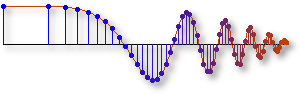If a system is linear, then distinct input signals do not interact
when they are processed by the system.
One example of this comes from making the input a sum of a sinusoid plus a rectangular pulse (i.e., a non-sinusoidal signal).
The output will contain a sinusoid at the same frequency plus the output due to the rectangular pulse.
When the filter is a first-difference filter, the output from a rectangular pulse consists of only two nonzero values (at the beginning and end of the pulse, so it is easy to identify the sinusoid in the output.
This input test signal is used with the following two filters
to exhibit the linearity property.
Another example of this comes from using two input sinusoids at different frequencies. When added together, the two frequency components are modified (in amplitude and phase) by the linear system just as if they had been processed alone.

1st difference filter |
Here is a block diagram example of linearity with the 1st difference filter. |

5-point averager |
Here is a block diagram example of linearity with the 5-point averager. |
